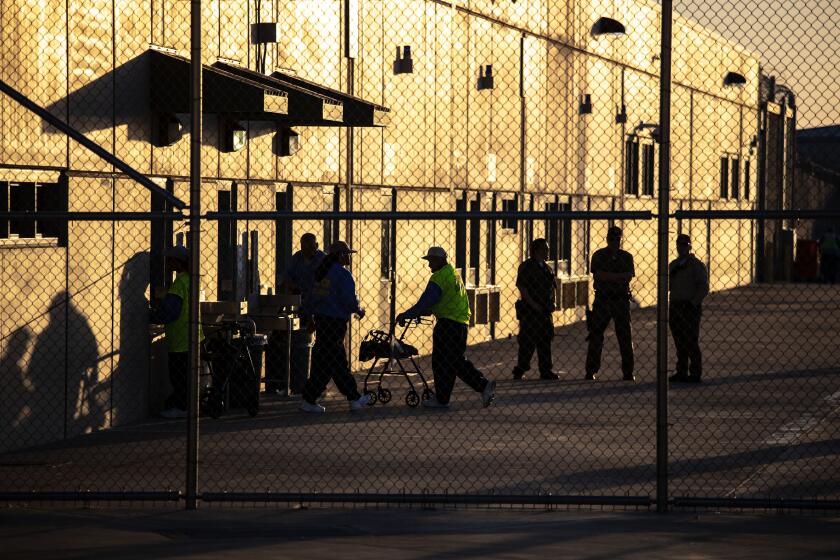5 things to know about big potential changes to California’s building laws

- Share via
Government runs on acronyms. In California, few inspire such strong reactions as CEQA.
Those four letters stand for the California Environmental Quality Act. It’s a state law that’s been around since 1970. Depending on whom you ask, it’s either the reason California retains its natural beauty in the face of unrelenting development pressure or why the state has plunged into a housing crisis.
You're reading the Essential California newsletter
The most important California stories and recommendations in your inbox every morning.
You may occasionally receive promotional content from the Los Angeles Times.
But now the Legislature is debating the most substantial overhaul to CEQA in generations. One proposal would exempt urban housing from its requirements and the other would weaken its rules for almost everything else.
Here’s why the law is so integral to California and what changes might do.
CEQA is simple. Its effects aren’t
The law is straightforward. CEQA requires proponents of a development — housing, highways, power plants, warehouses and many more — to disclose and, if possible, lessen its environmental effects before breaking ground. In practice these rules have meant thousand-plus page reports that include lengthy analyses of soil testing and traffic modeling, and sometimes endless litigation that puts entire projects at risk.
CEQA’s actual effects are disputed, but its role as a key point of leverage is not
Supporters of CEQA say the law is essential to preventing development from dirtying California’s waterways and mountain ranges and protects communities from harm. They say the law’s effects on stopping development are overblown, pointing to studies that show few projects face lawsuits.
Those who want CEQA overhauled respond that even threats to sue can derail projects, such as housing or clean energy infrastructure, that the state needs to be more affordable and respond to climate change.
The reformers contend that a project’s opponents weaponize the broad requirements in CEQA to try to stop the developments, including homeless shelters and a food bank in recent years, for reasons that have nothing to do with the environment.
CEQA politics are notoriously thorny, especially in the Democrat-dominated Legislature
Two of CEQA’s biggest fans are environmental and labor groups, influential constituencies in state politics. They’ve successfully resisted major changes to the law over the years and have learned to wield it.
So even though governors and lawmakers have talked a big game about CEQA changes, they’ve been able to pass relief only for specific pet projects or those willing to pay construction workers higher wages, or set aside a portion of the development for low-income housing or other benefits.
Now may be different thanks to changes inside and outside the Legislature
The two new bills have been proposed by veteran lawmakers who have written many of the CEQA and housing reforms in recent years, frustrated that large-scale development hasn’t followed.
Their efforts have been buoyed by a national “Abundance” movement that’s growing within Democratic circles. The argument goes that laws like CEQA in part drive the housing and infrastructure crises in blue states that are stifling the party’s political fortunes.
Gov. Gavin Newsom, who has embraced the call, endorsed the two bills and put them on a fast-track to approval as soon as this month.
What’s actually going to happen
Even opponents of the bills believe something is going to pass. But what that looks like remains an open question. One lawmaker indicated that some labor standards may be part of her bill, and the other’s bill was gutted in a legislative committee. All eyes will be on Newsom and legislative leaders in the coming weeks as they attempt to hammer out a final deal.
Today’s top stories

Regulators seek to phase out gas-powered appliances in Southern California
- Southern California’s air quality regulators are set to vote this week on new rules aimed at phasing out the sale of gas-powered furnaces and water heaters.
- Officials say the plan is crucial for reducing air pollution and improving public health, while opponents fear higher consumer costs.
Palm Springs accomplice fled to Europe after supplying ingredient for bomb
- Daniel Park allegedly helped Guy Edward Bartkus, the bombing suspect, secure 270 pounds of ammonium nitrate, an explosive precursor that can be used to construct homemade bombs.
- Bartkus is suspected of detonating a bomb at American Reproductive Centers in Palm Springs on May 17, killing himself and injuring four people.
- Days after the bombing, authorities say, Park left the U.S. for Europe. Polish law enforcement detained him Friday, and he was arrested Tuesday night at John F. Kennedy International Airport in New York after being deported, authorities said.
Labor groups push for a minimum wage of at least $25 an hour in L.A. County
- Labor advocates and some elected officials are calling on Los Angeles County to adopt a minimum wage of at least $25 an hour.
- The campaign is sure to face staunch resistance from business groups.
- It follows L.A. City Council’s approval of wage boosts for airport and hotel workers to $30 an hour by 2028, which hotel and tourism industry groups continue to fight.
Strip the name of gay rights icon Harvey Milk from a Navy ship?
- California leaders denounced reports that the Trump administration is preparing to strip the name of slain gay rights leader Harvey Milk from a naval ship honoring his legacy, calling it a slap in the face for the LGBTQ+ community just as Pride month begins.
- The Pentagon would not confirm or deny the plans but said Defense Secretary Pete Hegseth is committed to having ship names reflect a “warrior ethos.”
What else is going on
- California freshwater fish found to be teeming with parasites. How to keep from getting sick.
- The Trump administration sees ‘no viable path’ forward to finish the high-speed rail project, moves to pull federal funding.
- The Bakersfield girl who faced deportation and loss of lifesaving medical care is allowed to stay in U.S.
- A man was arrested in a string of violent attacks on a transgender woman in Westlake; two others are at large.
- ‘Dead man walking’: A SoCal man was charged with threatening to assassinate Trump.
- ‘Unfortunately, Altadena is for sale’: Developers are buying up burned lots.
Commentary and opinions
- As Trump fights diversity, this Black lawmaker is making history in Marin County, writes columnist Mark Z. Barabak.
- The president’s foreign policy is ‘Me, Myself and I,’ columnist Jackie Calmes argues — strictly transactional and motivated less by national interest than what’s in it, personally and politically, for him.
- Critics of anti-pandemic measures prompted schools to end mask mandates, but doing so exposed millions to COVID infection, contributing to nearly 22,000 deaths, writes columnist Michael Hiltzik.
This morning’s must-reads
A couple remodeled their Manhattan Beach home and ADU to create a modern, airy compound that connects to the outdoors without adding additional square footage.
Other must-reads
- This national landmark had to move because of a landslide. Inside what’s next for Wayfarers chapel.
- An elderly man builds a tree house to protest eviction from a state-owned home.
- Inside the making of ‘House of the Dragon’s’ ‘spectacular’ aerial battle.
- One Shot: How ‘Squid Game’s’ deadly carousel became a watchful eye.
For your downtime

Going out
- Museums: Guadalupe Rosales crafts an analog Wayback Machine for a vibrant show at Palm Springs Art Museum.
- Fashion: It’s time for seaside fashion and city strolls. Here are the hottest drops and events this summer.
- Restaurants: A celebrity KBBQ stalwart returns to Koreatown, with a new bar on the way.
Staying in
- Music: On her (very short) break from “Wicked,” Cynthia Erivo is performing with orchestras and releasing a new album called “I Forgive You.”
- Television: Beginning this fall, “Wheel of Fortune” and “Jeopardy!” will stream on Hulu and Peacock.
- Recipes: Here’s a recipe for Alba’s Spaghetti al Limone.
- ✏️ Get our free daily crossword puzzle, sudoku, word search and arcade games.
A question for you: What’s the best advice you’ve gotten from your father or father figure?
Virginia writes, “My dad gave me a strong sense of self as a smart Latina capable of doing anything I set my mind to. One of his favorite pieces of advice, liberally given, was that people would underestimate me and not to let them. This served me well as I entered the male dominated corporate world of the late 80s and 90s and eventually reached my goal at the top of the corporate ladder.”
Michael writes, “Son, you should always marry a short girl. When they [fart,] they don’t kick up as much dust.”
Email us at essentialcalifornia@latimes.com, and your response might appear in the newsletter this week.
And finally ... from our archives

On June 5, 1981, AIDS was reported for the first time following the detection of a rare form of pneumonia in five gay men in Los Angeles.
Last year, as part of the Times’ Our Queerest Century project, columnist LZ Granderson wrote about how we must remember the heroes of the AIDS epidemic, not just the trauma.
Have a great day, from the Essential California team
Kevinisha Walker, multiplatform editor
Andrew Campa, Sunday writer
Karim Doumar, head of newsletters
How can we make this newsletter more useful? Send comments to essentialcalifornia@latimes.com. Check our top stories, topics and the latest articles on latimes.com.
Sign up for Essential California
The most important California stories and recommendations in your inbox every morning.
You may occasionally receive promotional content from the Los Angeles Times.








